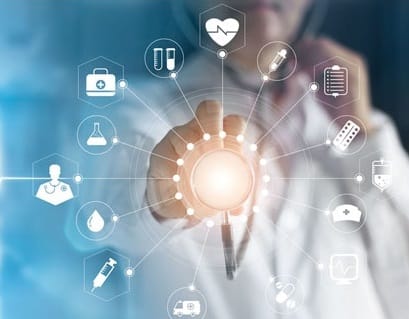Master Data Management In Healthcare

IT leaders considering Master Data Management (MDM) for their healthcare organization already know the importance of having a solid MDM approach. But that doesn’t make the task any less daunting. Their questions for us include “What is the right MDM strategy for my organization?” Or, “Will an enterprise data warehouse (EDW) solve my MDM problems?”
MDM is, indeed, a topic of frequent discussion with our new health systems and prospective partners. Based on those conversations, we’ve developed a primer for MDM, strategies for approaching it, and when an EDW might be the best solution.
What is Master Data Management?
Our first order of business is to define master data. Master data is critical business data shared among multiple systems. In healthcare, we divide master data into two types:
- Identity data—such as patient, provider, and location identifiers
- Reference data—which includes common linkable vocabulary like ICD, DRG, SNOMED, LOINC, RxNorm, and order sets – Master data management is, at its most basic, the process of linking identity data and reference data across multiple IT systems into a single, consistent point of reference. That single point of reference could be a patient, or it could be a procedure code. A more formal, all-encompassing definition we give to MDM is the following:
MDM comprises the processes, governance, policies, standards, and tools that consistently define and manage the critical data of an organization to provide a single point of reference.
Accurately linking both reference and identity data is extremely important for a robust health system IT environment. However, for our purposes here we’ll refer mostly to identity data. Managing identifiers is the foundation of MDM. If you can’t do that well, you won’t be able to succeed at the complex task of managing reference data.
Why It’s Important
Three main drivers are making MDM more important than ever in the healthcare industry:
- Mergers and Acquisitions (M&A): The IT systems of organizations involved in M&A are rarely the same, and each organization has its own master data. So, M&A frequently involves merging data from similar systems (for example, provider identifiers from two separate EMR systems) so that the data can be used across the organization.
- Health information exchanges (HIEs): To successfully exchange information across locations and organizations, HIEs have to be able to reconcile master data. For example, an HIE sponsored by a health system will need to ensure that its master patient identifiers can be matched with the patient IDs of its affiliated practices.
- ACOs: To understand and manage their patient populations, ACOs bring together health system data and payer data. Bringing these two very different systems together requires sophisticated MDM to ensure that the payer-organization’s master data matches provider-organization master data.
In real-world situations, there can be quite a bit of overlap among these three categories. For example, an ACO is typically involved in an HIE as well, and the ACO’s sponsoring provider might be going through a merger. (It’s this level of complexity that keeps technology wonks like us on our toes.)
Three Approaches to Data Management
The next question that any healthcare organization (ACO or not) must address is how to tackle MDM. Currently, three main approaches are available:
- IT system consolidation
- Upstream MDM implementation
- Downstream master data reconciliation in an enterprise data warehouse (EDW)
We’ll discuss the pros and cons of the first two approaches briefly. Then we’ll spend some time talking about when it is appropriate to use an EDW to solve MDM problems.
IT System Consolidation
What it is?
A popular way to address many of the MDM challenges within an organization is to abandon best-of-breed solutions in favor of monolithic EMR and ERP solutions. These solutions are the Epics and Cerners (of the clinical realm) and the Lawsons and Peoplesofts (of the business processes realm). Implementing these consolidated solutions involves reconciling all of an organization’s master data—and then the monolithic solutions become “masters” of the data in their respective realms.
Pros:
In addition to its relative comprehensiveness, you get another benefit of this approach: when MDM is handled at the level of these transactional systems, master data is reconciled at the time of the transaction. For example, a patient is matched at the moment that she or he is registered in the system rather than upstream or downstream.
Cons:
Naturally, the drawback of IT consolidation is its complexity and its expense. These systems are not cheap, and the changeover consumes significant resources.
It is also important to realize that, while these initiatives solve master data challenges within an organization, when there is a desire to integrate outside data with mastered organizational data, there may be a need for more MDM between the data sources.
Upstream MDM Implementation
What it is?
In an upstream MDM implementation, organizations keep their disparate IT systems but map their master data through a third-party tool such as an enterprise master patient index (EMPI).
Pros:
Although master data problems aren’t reconciled in the source (as is possible with IT consolidation), they are reconciled very near the source. In addition, these systems allow for extensive manual adjudication.
Cons:
This approach might seem more attractive on paper than a massive IT consolidation initiative, but most organizations favor IT consolidation over upstream MDM implementation. This is because upstream implementations tend to be complicated, large, expensive, and slow-moving IT projects. We find that this approach has a high failure rate.
When an EDW Is the Right Solution for Master Data Management?

What if the two approaches we just described don’t appeal to an organization? Is an EDW the right alternative for an MDM strategy?
Our response to that question is a resounding “maybe.“
At Health Catalyst, we implement an EDW platform, analytics applications, and processes that enable healthcare organizations to use their data to drive higher-quality, lower-cost care. As such, MDM isn’t the principal focus. But that doesn’t mean an EDW can’t help with MDM challenges. If an organization has already mastered its data, an EDW can work with whatever MDM approach has been adopted. And if the organization hasn’t solved its MDM problems, resolving issues with common linkable identifiers and common linkable vocabulary in an EDW platform is an option.
The main benefit of using an EDW to master data is that it is a very achievable solution to the problem. The main drawback of this approach, however, is that the mastered data is only available for analytics.
An EDW will not solve master data challenges at the level of transactional systems.
The following are the main instances when it is best to use an EDW for master data management:
When an organization needs to do analytics, but doesn’t have another MDM solution in place.

To survive in the healthcare industry of today, every health system needs to implement analytics that help drive higher-quality, lower-cost care. A system shouldn’t put off analytics just because it doesn’t have an MDM solution already in place. An EDW can fill MDM needs in a smooth manner so that the organization can move forward with analytics to eliminate waste, improve margins, and successfully participate in value-based initiatives.
This also applies to situations where a third-party MDM solution initiative falters or fails. We’ve mentioned how risky these upstream MDM implementations are. The EDW can step in and resolve MDM problems for analytics purposes while the health system sorts out what to do about transactional data matching.
When an organization inevitably starts integrating data sources from outside its consolidated infrastructure or its EMPI.
As soon as a health system encounters an important data source that isn’t integrated into its chosen MDM solution, the organization may need an EDW to handle that integration. We can cite several examples of health systems with MDM solutions in place who have subsequently needed to integrate data from a source outside of their consolidated systems or EMPI.
MDM In Action: Claims Data
The most common example we’ve encountered involves claims data. More and more of our health systems are participating in ACOs. This participation requires health systems to perform analytics that incorporates claims data from external sources—and their MDM solutions aren’t equipped to reconcile payer master data with provider master data. We have been able to step in and handle that integration for them downstream in the EDW.
In an era of healthcare reform, reporting and regulatory requirements are shifting all the time. The ways we handled data 10 years ago may not be good enough today. The solutions we have in place now for managing master data may not be comprehensive enough to encompass all the data a healthcare organization will need to leverage. An EDW can step in and bridge any gaps in an organization’s MDM strategy.
Source: https://www.healthcatalyst.com/insights/5-reasons-healthcare-data-is-difficult-to-measure
Tags
Bestarion Website Admin



